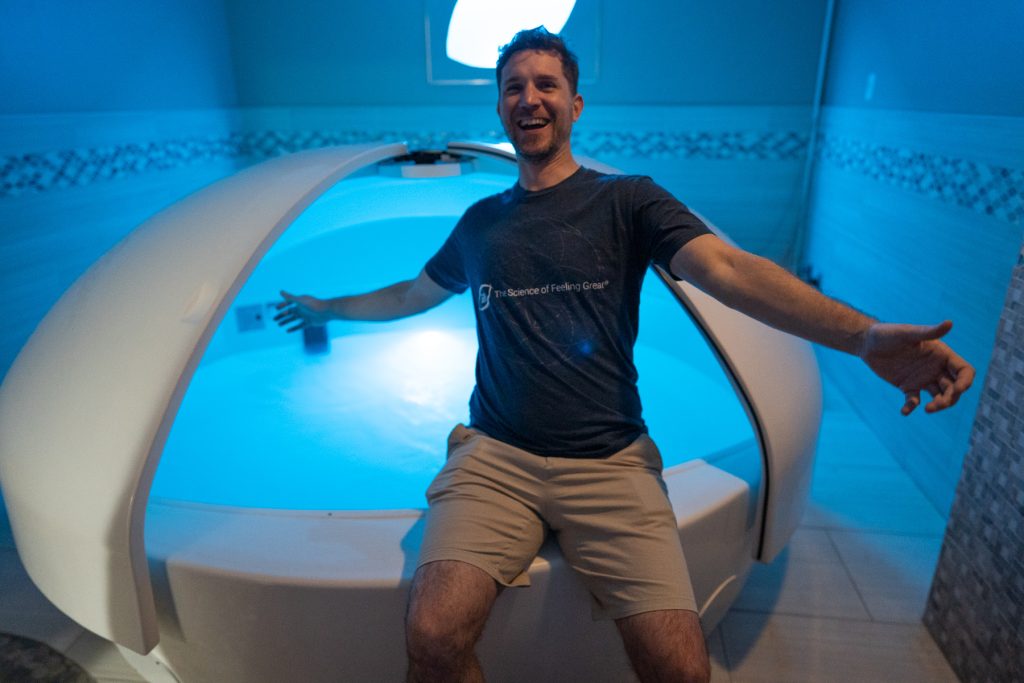Float Therapy: How it Works, Benefits, Risks and Side Effects

Float therapy, also known as floatation therapy, sensory deprivation therapy, or isolation tank therapy, is a wellness practice that involves immersing oneself in a sensory isolation tank or float tank filled with a shallow pool of warm water saturated with Epsom salt (magnesium sulfate). The high salt concentration in the water allows individuals to effortlessly float on the surface.
Here’s how float therapy typically works:
1. The Float Tank: Float tanks are usually enclosed, soundproof, and lightproof chambers designed to minimize external sensory input. They come in various shapes and sizes, but they all aim to create an environment where you can experience complete sensory deprivation.
2. Buoyancy: Thanks to the saltwater’s buoyancy, individuals float effortlessly, relieving pressure on their joints and muscles. This sensation is often described as feeling weightless.
3. Sensory Deprivation: The isolation tank is designed to eliminate external stimuli such as light, sound, and temperature variations. This creates a unique environment where individuals can experience sensory deprivation.
4. Relaxation and Meditation: Many people use float therapy as a form of relaxation and meditation. With sensory distractions reduced to a minimum, individuals can focus their thoughts, engage in mindfulness practices, or simply unwind in a state of deep relaxation.

Benefits of floatation therapy
During floatation therapy, the high salt concentration in the water allows individuals to effortlessly float on the surface, creating a unique environment for relaxation and various potential health benefits that can include:
1. Stress Reduction: Stress is an ever-present factor in our fast-paced lives, and finding effective ways to manage it is crucial for overall well-being. Float therapy offers a respite from the daily grind. The sensory deprivation and relaxation effects of floating help reduce stress by eliminating external stimuli that contribute to anxiety. Inside the float tank, you are cocooned in a serene environment free from distractions, allowing your mind and body to unwind and release tension.
2. Pain Relief: Many people turn to float therapy to alleviate physical discomfort, especially those with chronic pain conditions. The buoyant saltwater supports the body, relieving pressure on joints and muscles. This weightlessness can ease pain associated with conditions like arthritis, fibromyalgia, and back pain. Additionally, the magnesium in Epsom salt is known for its muscle-relaxing properties, further contributing to pain relief during a float session.
3. Enhanced Creativity: Floating can have a profound impact on cognitive functions, with some users reporting increased creativity and problem-solving abilities after a float session. The sensory isolation tank provides a blank canvas for your mind to explore new ideas, visualize solutions to problems, and tap into your creative potential. This enhanced mental clarity can extend beyond the float session, benefiting your work and daily life.
4. Improved Sleep: Quality sleep is essential for overall health and well-being, yet many people struggle with sleep disorders or poor sleep quality. Float therapy can help improve sleep by reducing stress and promoting relaxation. After a float session, individuals often report feeling more rested and experiencing deeper, more restorative sleep. The relaxation induced by floating can also aid in falling asleep more easily.
5. Mindfulness and Mental Clarity: In a world filled with constant distractions, finding moments of mindfulness and mental clarity can be challenging. Float therapy provides an ideal environment for meditation and mindfulness practices. The sensory deprivation tank eliminates external stimuli, allowing you to focus on your thoughts, emotions, and breathing. This heightened sense of awareness can lead to increased self-reflection, emotional balance, and improved mental clarity.
6. Athletic Recovery: Athletes and fitness enthusiasts often turn to float therapy as part of their recovery and performance enhancement routines. The buoyancy of the saltwater supports post-workout recovery by reducing muscle soreness and tension. It also aids in the elimination of lactic acid buildup, which can occur after intense physical activity. Floating can help athletes recover faster, reduce the risk of injury, and enhance overall athletic performance.
7. Enhanced Well-Being: Many individuals find that float therapy contributes to an overall sense of well-being and relaxation. The combination of reduced stress, pain relief, improved sleep, and mental clarity can lead to a profound sense of tranquility and contentment. Regular float sessions are often seen as a form of self-care and a way to maintain a balanced and healthy lifestyle.
Floatation Therapy and Anorexia
A study conducted with 68 women and girls hospitalized for anorexia treatment in Tulsa, Oklahoma, has shown promising results regarding the benefits of float therapy for individuals with anorexia nervosa. Float therapy involves sensory deprivation in a float tank filled with Epsom salt water, helping people become more attuned to their body signals. Participants in the study who engaged in one-hour float therapy sessions twice a week for four weeks demonstrated significant reductions in body dissatisfaction, immediately following the sessions and at the six-month follow-up. This was measured using the Photographic Figure Rating Scale, which asks participants to choose a body silhouette that corresponds to how they see their current body and how they want it to appear. After float therapy, participants more accurately perceived their body size, choosing silhouettes that aligned with their actual BMI. Additionally, the therapy helped alleviate anxiety immediately after sessions.
Anorexia nervosa is characterized by an abnormally low body weight, intense fear of gaining weight, and distorted perceptions of weight. Those affected often engage in extreme behaviors to prevent weight gain, such as severe calorie restriction, vomiting after eating, laxative abuse, or excessive exercise. It is a life-threatening disorder, with a high mortality rate, and recovery can be challenging due to body dissatisfaction and distorted self-perception. While the study’s results appear promising, experts like Dr. Victor Fornari, a child psychiatrist at Northwell Health, stress that anorexia patients should continue with their usual care and view float therapy as a supplemental treatment. Typical treatment for anorexia includes hospitalization for medical complications, psychotherapy, medical care for co-morbidities, healthy weight restoration, and support from family and friends. The causes of anorexia are complex, involving biological, psychological, and social factors, including genetics, family history, trauma, and mental health conditions.
It’s important to note that while float therapy offers numerous potential benefits, individual experiences may vary. Some people may find it more effective than others for specific purposes. Moreover, if you are considering float therapy, it’s advisable to consult with a healthcare professional, especially if you have any underlying medical conditions or concerns. Additionally, choosing a reputable and well-maintained float therapy facility is crucial to ensure a safe and enjoyable experience.
Risks and Side Effects Of Float Therapy
While float therapy can offer various benefits for relaxation and well-being, it’s important to be aware of potential risks and side effects, although they are generally minimal. Here are some of the considerations:
1. Skin Irritation: The high salt concentration in the float tank water can sometimes cause skin irritation, particularly if you have open cuts, scrapes, or sensitive skin. To mitigate this risk, float centers typically provide guidelines for skin preparation, such as avoiding shaving immediately before a session and using petroleum jelly on any cuts or sensitive areas.
2. Eye Irritation: The saltwater can irritate the eyes if it comes into contact with them. Float centers usually provide eye protection in the form of goggles or eye drops to prevent this. It’s crucial to use these as directed to protect your eyes during the session.
3. Claustrophobia: Being enclosed in a sensory isolation tank might trigger feelings of claustrophobia or anxiety in some individuals. To minimize this risk, many float tanks have lights and the option to leave the tank door partially open, allowing you to control your level of comfort.
4. Dizziness or Nausea: Some people may experience a mild sense of dizziness or nausea during or after a float session. This can be due to the feeling of weightlessness and the transition between the float tank and the outside world. Staying hydrated before and after the session can help alleviate these sensations.
5. Infection Control: While float centers generally maintain high levels of hygiene and water quality, there is always a minimal risk of infection, much like swimming in a pool. Ensure that the facility you visit follows proper sanitation and filtration procedures for the float tank water.
6. Overuse: Using float therapy excessively, such as for extended periods every day, could potentially disrupt your natural balance and lead to a dependency on the experience for relaxation. It’s generally recommended to use float therapy in moderation as a complementary wellness practice.
7. Psychological Effects: Some individuals may experience unexpected emotions or vivid sensory experiences during a float session, which could be distressing for some. However, these psychological effects are usually transient and should not be a major concern for most people.
8. Ear Issues: If you have a history of ear infections or ear problems, floating could potentially exacerbate these issues, as water might enter the ears during the session. Using earplugs can help reduce this risk.
It’s essential to discuss any concerns or medical conditions with the staff at the float center before your session. They can provide guidance and accommodations to ensure a safe and comfortable experience. Overall, while there are potential risks associated with float therapy, they are generally minimal, and most people can enjoy the benefits of relaxation and stress reduction without experiencing significant side effects. Always choose a reputable float center with well-maintained facilities and follow their guidelines to minimize any potential risks.
In conclusion, float therapy is a unique and holistic wellness practice that combines relaxation, sensory deprivation, and potential therapeutic benefits. Whether you seek stress reduction, pain relief, enhanced creativity, better sleep, mindfulness, athletic recovery, or an overall sense of well-being, float therapy offers a tranquil escape from the demands of everyday life, allowing you to rejuvenate your mind and body.





